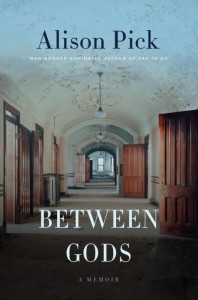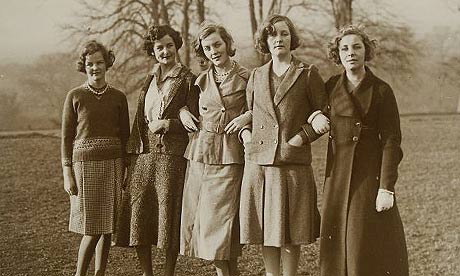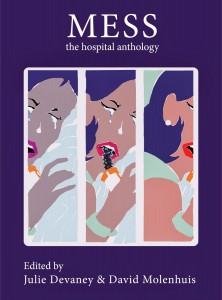September 29, 2014
May Friedman on Mommyblogs and uncertainty as a valuable critical end
 “In trying to form conclusions about mommybloggers—and about mothers—I am reminded of my children attempting to jump upon their own shadows: I am attempting to trap an essentially untrappable form of knowledge. After the initial discomfort and frustration that this inconclusive conclusion elicits, however, I have found that there is much to gained, as a researcher in general and as a motherhood researcher in particular, in looking instead at uncertainty as a valuable critical lens.” –May Friedman, Introduction, Mommyblogs and the Changing Face of Motherhood
“In trying to form conclusions about mommybloggers—and about mothers—I am reminded of my children attempting to jump upon their own shadows: I am attempting to trap an essentially untrappable form of knowledge. After the initial discomfort and frustration that this inconclusive conclusion elicits, however, I have found that there is much to gained, as a researcher in general and as a motherhood researcher in particular, in looking instead at uncertainty as a valuable critical lens.” –May Friedman, Introduction, Mommyblogs and the Changing Face of Motherhood
This is a kind of criticism that does not pit the critic against the text, does not seek authority. It seeks instead to travel with the work and its ideas, invite it to blossom and invite others into a conversation that might have previously seemed impenetrable, to draw out relationships that might have been unseen and open doors that might have been locked.” —Rebecca Solnit, “Woolf’s Darkness: Embracing the Inexplicable”
It pains me to link to this smug and stupid post I wrote in May 2009, just 11 days before my first child was born. When I purported to understand anything in Rachel Cusk’s A Life’s Work, because I really didn’t. And when I tried to pin down mommybloggers, detailing my discomfort with the form, and my discomfort with that discomfort. I thought I had it all sewed up, because I was surer of things then, and I had no idea of the seas of uncertainty I’d be wading into when it came to mothering, motherhood, and issues around motherhood. Five years later, The M Word was to be partly my means of coming to terms with the beauty of the mess of it all—when in doubt, make an anthology.
When, three months after that embarrassing 2009 blog post, I reviewed the book Mothering and Blogging: The Radical Act of the Mommy Blog by May Friedman and Shana Calixte, my thinking had evolved somewhat, but I was still pretty stupid. (This is the curse of any blogger: you are forever presented with undeniable evidence that you were pretty stupid. And that mostly likely you still are.) But I was getting a sense of things—that motherhood and any ideas surrounding motherhood refused to stay put in my tidy pat conclusions, and that there were many women who didn’t want even them to.
May Friedman’s new book, Mommyblogs and the Changing Face of Motherhood, occurs at a pivotal intersection in my writing life. Outside of my blog, it is my writing about motherhood and my mothering life that has found most resonance with readers, so much so that when a recent published story contained nary a reference to mothers anywhere, I was a bit relieved. And I’ve also been blogging for 14 years this October, which has led to the opportunity to teach the course, The Art of Blogging, at the University of Toronto (whose latest session starts a week from tonight!). In my blog teaching, I embrace and celebrate the messy chaos of the blog form, as unpindownable as mothers are. (You can read my posts with thoughts on blogging here.) I welcomed the reflections, revelations and insights of Mommyblogs and the Changing Face of Motherhood not just for what they had to say about mothers and mommyblogs, but for the perspective the book provided on the history and implications of the blogosphere with a lens on women (who, as in any history, are so often left out of the story).
True confession: I have an allergy to Foucault, and once they start referencing Bahktin, they’ve already lost me. As an academic text, Friedman’s book stands apart from others that I’ve encountered in that her critical framework serves to transform the familiar into something altogether new, rather than rendering it intelligible. In Mommyblogs and the Changing Face of Motherhood, she examines mommyblogs in the frameworks of hybridity (as a form, of the identities of blog authors, of the experiences of readers), cyborgs (of the author and her text via technology, and also of the complex and nuanced networks created through blogging communities, how mothering is reworked away from being an individuated task) and Queer theory (a movement away from the patriarchal institution of motherhood toward an otherness) to show that mommyblogging is indeed a radical act that has already changed the way motherhood is regarded in the public sphere, and whose further implications are still before us, rich with possibility.
It is as applicable to that mythic blogosphere as a whole what Friedman has to say about “the mamasphere”: “It is precisely because it is impossible to say anything generalizable about the mamasphere as a whole that it is a radical maternal space; not as a result of the activism of individual mothers, but because of the implications of all these narratives coexisting, and the endless unspooling dialogue that therefore emerges.” That lack of generalization doesn’t freak me out anymore, and I appreciate Friedman’s excellent book for reminding me why certainty is anathema to everything I like best about the world, both online and off.
See also: “Mary Pratt, On Blogging, and Preserving Light and Time”
September 28, 2014
New Books by The M Word Authors
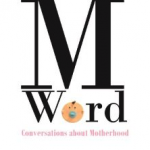 In many ways, it seems impossible to believe that the wondrous reception of The M Word last spring could have ever happened. I still can’t fathom the generosity of both the readers and the writers involved with this project, and I’m so proud of the book itself and the further conversations it has generated since it was published. But a particularly cool experience for me has been seeing elements of the essays at play in their writers’ latest works. If you enjoyed The M Word, I urge you to check out these new books by four writers from the anthology.
In many ways, it seems impossible to believe that the wondrous reception of The M Word last spring could have ever happened. I still can’t fathom the generosity of both the readers and the writers involved with this project, and I’m so proud of the book itself and the further conversations it has generated since it was published. But a particularly cool experience for me has been seeing elements of the essays at play in their writers’ latest works. If you enjoyed The M Word, I urge you to check out these new books by four writers from the anthology.
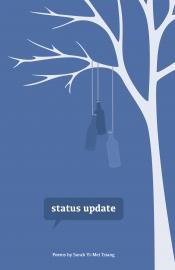 Status Update, by Sarah Yi-Mei Tsiang:
Status Update, by Sarah Yi-Mei Tsiang:
The “book of secrets” referred to in Sarah Yi-Mei Tsiang’s essay, “Mommy Wrote a Book of All My Secrets” was actually this book, Tsiang’s latest book of poetry, which was nominated for the Pat Lowther Award in the spring. It’s a collection of poetry inspired by Facebook status updates, which is only the beginning of what is interesting about this funny, beautiful book and I loved so much when I read it in June.
Between Gods, by Alison Pick:
I’ve not read Between Gods yet—I am hoping to stop by the launch this week and pick up a copy there. But the book has been receiving goods reviews and was a bestseller the week it was released. And I know that Pick’s essay from The M Word, “Robin”, appears in a reworked form in the memoir. I am looking forward to find out how it fits into a larger context.
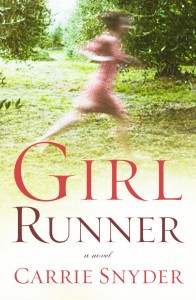 Girl Runner, by Carrie Snyder:
Girl Runner, by Carrie Snyder:
The connections between Snyder’s essay in The M Word, “How to Fall”, and her new novel, Girl Runner, are more oblique, but when I read the book, I couldn’t help but notice Aganetha Smart’s insistence on never falling (which is pretty much gravitationally impossible) in the novel. Girl Runner has been receiving great reviews, and will be published in countries all over the world in 2015.
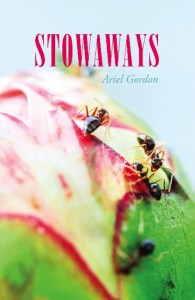 Stowaways, by Ariel Gordon:
Stowaways, by Ariel Gordon:
Gordon’s essay in The M Word, “Primapara”, contains a poem called “Primapara”, which appears also in her new collection, Stowaways. This would be the poem with the immortal line, “If I had had twins, I would have eaten one.” The entire collection is just as mordant and intriguing, the familiar rendered from a whole new point of view.
September 27, 2014
Best Book of the Library Haul: I Like Old Clothes
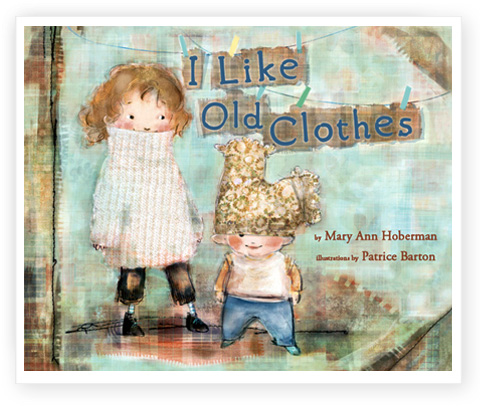 Here is a secret to living well in the city on a salary and a half—we buy all our children’s clothes at Value Village. Which is cheaper than even Wal-Mart, and this way we don’t have to go to Wal-Mart, plus my children get to wear clothes first purchased by people who valued quality, long-lasting, stylish children’s clothing (not Wal-Mart) as much as I do. Everybody wins, but us in particular (and with the money we saved, we go out and buy books).
Here is a secret to living well in the city on a salary and a half—we buy all our children’s clothes at Value Village. Which is cheaper than even Wal-Mart, and this way we don’t have to go to Wal-Mart, plus my children get to wear clothes first purchased by people who valued quality, long-lasting, stylish children’s clothing (not Wal-Mart) as much as I do. Everybody wins, but us in particular (and with the money we saved, we go out and buy books).
So I was quite excited to encounter the picture book I Like Old Clothes by the wonderful Mary-Ann Hoberman, an reissued edition with gorgeous new illustrations by Patrice Barton. It’s a story about the delights of second-hand clothing and hand-me-downs, the treasures discovered and, most importantly, the stories these clothes carry in their threads about all the people who’ve ever worn them and all the places they’ve been.
“‘You lived in East Bend, / Blue Sweater,’ I say. / ‘Just think, you are living / in my town today.’”
It’s an empowering thrifter’s manifesto, a story that gets kids excited about the economical and ecologically sound practice of buying second-hand. A brilliant antidote to rampant messages of consumerism found elsewhere, and the just the thing to make parents and kids feel good about the choices their family makes.
September 25, 2014
How to Build a Girl by Caitlin Moran
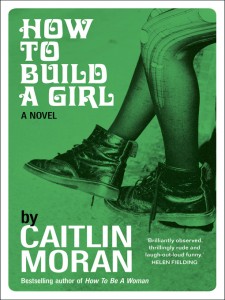 Caitlin Moran was such a revelation when I first encountered her two and half years ago (precisely here, if you’re wondering), and I adored How to Be a Woman, have reread it since, as well as her anthology of columns, Moranthology, and I even tracked down a copy of The Chronicles of Narmo, the novel she published when she was 14, just because I wanted to read everything she’d ever written. So I wasn’t actually sure I needed to read her new book, the novel, How to Build a Girl, which takes on a similar trajectory to her memoir and long-ago first novel (which doesn’t count, asserts the bio in her new book, which purports to be her “debut” novel). It’s the shape of her own life story—working class girl becomes a rock journalist at tender age, catapulted into awesomeness from an upbringing spent eating blocks of cheese and being a social outcast. So by this, the third time, I sort of thought Moran might have that area covered. I approached the novel warily—but I loved it. To read anything Caitlin Moran writes is to laugh a lot and get everybody in your presence wondering just what is so hilarious. Oh, it’s ribald, brutal, gorgeous and profound. Um, packed with references to Annie. And I guess I’ve read enough Caitlin Moran to know that How to Build a Girl actually departs from her autobiography in a lot of ways, and I didn’t conflate her heroine with the author. I adored her straightforward depictions of a young woman’s sexuality (she calls herself a “sex pirate”, a “swashfuckler”), the pitch perfect pop culture references, the Caitlin Moran-ish tirades that popped up throughout the narrative, which were familiar—on living in poverty, the power of music, and the power of books to build you a whole other other world. And oh, the parts where young Johanna is so desperately trying to be “legendary”, drunk out of her tree, talking about all the sex she’s ever had because she’s going to be the person who’s had all the sex and who’s to know if she doesn’t talk about it? Saints preserve us all.
Caitlin Moran was such a revelation when I first encountered her two and half years ago (precisely here, if you’re wondering), and I adored How to Be a Woman, have reread it since, as well as her anthology of columns, Moranthology, and I even tracked down a copy of The Chronicles of Narmo, the novel she published when she was 14, just because I wanted to read everything she’d ever written. So I wasn’t actually sure I needed to read her new book, the novel, How to Build a Girl, which takes on a similar trajectory to her memoir and long-ago first novel (which doesn’t count, asserts the bio in her new book, which purports to be her “debut” novel). It’s the shape of her own life story—working class girl becomes a rock journalist at tender age, catapulted into awesomeness from an upbringing spent eating blocks of cheese and being a social outcast. So by this, the third time, I sort of thought Moran might have that area covered. I approached the novel warily—but I loved it. To read anything Caitlin Moran writes is to laugh a lot and get everybody in your presence wondering just what is so hilarious. Oh, it’s ribald, brutal, gorgeous and profound. Um, packed with references to Annie. And I guess I’ve read enough Caitlin Moran to know that How to Build a Girl actually departs from her autobiography in a lot of ways, and I didn’t conflate her heroine with the author. I adored her straightforward depictions of a young woman’s sexuality (she calls herself a “sex pirate”, a “swashfuckler”), the pitch perfect pop culture references, the Caitlin Moran-ish tirades that popped up throughout the narrative, which were familiar—on living in poverty, the power of music, and the power of books to build you a whole other other world. And oh, the parts where young Johanna is so desperately trying to be “legendary”, drunk out of her tree, talking about all the sex she’s ever had because she’s going to be the person who’s had all the sex and who’s to know if she doesn’t talk about it? Saints preserve us all.
My feelings about Caitlin Moran’s work are always connected to myself, the ways in which I’m so inspired by her ideas and her point of view. They’re also tangentially connected to the vitriol she inspires in her critics (for reasons worth considering and otherwise). The personality looms large, but obscures an essential and pivotal point: Caitlin Moran is an amazing writer. Presenting her own story like an every woman’s tale, you too can make it from a Wolverhampton Council House to the Times of London and columnist of the year. Except you can’t. She is so incredibly smart and her work is so rich and funny. The novel is structurally messy in places (tenses are confused, perspective moving in an out of time), but the prose is taut, even the tangents perfectly primed. Her Johanna Morrigan is such a vivid voice, bringing the whole world around her to life. And for once, I disagree with Laura Miller (shocking, I know) that How to Build a Girl “is just not fiction”, has “diluted charms.” Because they overwhelmed me, those charms. I was totally sold. This book bowled me over with greatness.
September 24, 2014
Marvelling at The Mitfords
I am sad that today we live in a world without a Mitford sister, not a single one, as The Duchess of Devonshire has died at the age of 94. Debo was close to my heart as it was to her Chatsworth House that I visited in 2004 whilst experiencing a throat infection, and fell down in a faint among the sheep droppings, and it was still worth the trip. This was at the height of my Mitford-mania, after I read Mary S. Lovell’s The Mitford Girls and became utterly fascinated. They were connected to everything! Debo’s husband’s late brother’s wife’s was John F. Kennedy’s sister, Kathleen. The commonplace variety of banana is called Cavendish was named in the 15th century for her family line. Plus she was a Duchess. Sister Nancy was the comic novelist; Diana divorced a Guinness to marry Oswald Mosley, which led to a falling out with Decca, who became a communist and ran away to fight in the Spanish Civil War (before immigrating to America to become a journalist); Pamela was a lesbian, and otherwise (comparatively) dull, except she had an Aga that matched her eyes; and yes, Unity, Hitlers girlfriend, who shot herself in the head at the advent of World War Two. Has non-fiction ever been so fascinating? They were like the Spice Girls, but smarter, longer lived, and with fascism. Such amazing, compelling lives. (I love that they were fictionalized in Jo Walton’s excellent Small Change trilogy).
I have a whole shelf packed with Mitford books—the Lovell biography, theirs and Decca’s collected letters, Decca’s non-fiction and autobiographies, Nancy’s novels, and even Debo’s collection of columns, Counting My Chickens. I cherish every one of these and always will, even more so now that the sisters are all gone. Stranger than fiction—they’re proof of that. The best and worst of Englishness—they’re a reminder of the spectrum of human experience.
I even wrote a poem about them, back in the time in which I did such things as write poems.
Extremism was so fashionable that first season
“Why must all my daughters fall for dictators?”
~ Lady Redesdale (Sydney Mitford)
Extremism was so fashionable
that first season.
At the races my daughter won herself a diplomat
and my husband and I my husband and I
concerned with crashing stocks had our veritable sigh
and we folded our hands and nodded then,
as he stood on a box and took up his pen
because she looked on so loving
I couldn’t help but be pleased,
in spite of his wife, in spite of their life
and his radical politics leaning far right.
There was the matter of war in Spain
which (she said) was just a prelude.
This was the littlest daughter, always contrary,
“I will run away, you’ll all be sorry.”
When she finally fled, it was to throes of war
and she didn’t bring a stitch to wear,
to fight for the reds or marry for love
just to be where the action was happening.
She had to deny her former life
to prove her worth as working-class wife,
they came back to fight for the cause from their home
on the slummier side of South London.
The man of the year was a small man
seeking room to grow.
My middle daughter found him on her travels
my sullen, silly girl, by his words became so serious
when she sang them in her own voice
we consented, it was her choice
but he was such a charming gentleman
when he had us all to tea.
(But this is when the trouble starts, as you will see)
Solidarity was demanded on the homefront
but for us, this was impossible.
My golden older daughter and her lover- now her husband-
the coincidence of their ideological proximity
translated to sympathy for the enemy
and this daughter of mine, fond of long days and wine,
spent war years charming the Holloway Prison for Women.
The littlest one fled to America, still wedded to her cause,
kept her affiliations testifiable, and sincerity undeniable-
she had rallies and babies and books to write and
for seventeen years she refused to cross the line,
she fought the fascist front known as The Family
My husband and I- my husband and,
as his opinion of the Germans was established years before
when he’d lost a lung fighting in the First World War
and he could not abide by the company
of the leader with whom I’d had the pleasure of tea.
Especially not while the world was coming apart
at its bursting Versaillesian seams.
And my silly daughter could not abide by bursting seams
to choose between England and the man of her dreams
on September first, nineteen thirty-nine
she put a gun to her temple in an attempt to stop time.
My outspoken daughters had been drawn to men
who could outspeak them.
They dared to defy us with dictators- an original act of rebellion-
typical; no middle men, they loved instead
their moustaches and regalia their marching men with unbending knees
Prussian fortitude, Yugoslavian ingenuity
and all those ideals that had the trains run on time.
I could not raise a shallow woman; my daughters
my twentieth-century casualties, there was a time
behind every powerful man was a good woman
and I had birthed nearly all of them.
September 23, 2014
Excellent Things
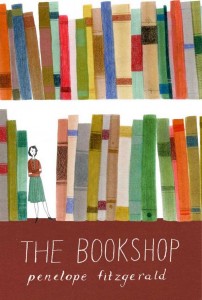 I have been hearing rumours for some time that Penelope Fitzgerald’s novels were to be issued with covers by my very favourite illustrator in the universe, Julie Morstad, and these rumours seem to have manifested into reality. I am so excited. Each of the covers is so intriguing and delightful, and I may have to end up owning every single one of them. Elsewhere, I adored the essay “Love Song to My Belly” in Brain, Child Magazine by Goldberry Long, who is the best writing teacher I have ever had. And closer to home, I got to see Caitlin Moran at the Toronto Reference Library last night, and she was wonderful, plus everyone I know was there, and I got to pick up a copy of her novel, How to Build a Girl, which I’m reading now and keeps making me guffaw, which makes everyone around me uncomfortable.
I have been hearing rumours for some time that Penelope Fitzgerald’s novels were to be issued with covers by my very favourite illustrator in the universe, Julie Morstad, and these rumours seem to have manifested into reality. I am so excited. Each of the covers is so intriguing and delightful, and I may have to end up owning every single one of them. Elsewhere, I adored the essay “Love Song to My Belly” in Brain, Child Magazine by Goldberry Long, who is the best writing teacher I have ever had. And closer to home, I got to see Caitlin Moran at the Toronto Reference Library last night, and she was wonderful, plus everyone I know was there, and I got to pick up a copy of her novel, How to Build a Girl, which I’m reading now and keeps making me guffaw, which makes everyone around me uncomfortable.
And a strange thing: I spent the weekend rereading the wonderful Chez L’Arab by Mireille Silcoff for a review I’m writing for CNQ. I read it first a month ago, followed by Joan Thomas’s The Opening Sky. And found it odd that both books referenced the same zen koan, “No Water, No Moon.” So that was weird. But it gets even weirder, because upon rereading Silcoff’s collection, I was reminded that a character in the story not only reads the paragraph, but then goes on to encounter it in a podcast shortly after, the koan an uncanny echo in the story just as it was in my own experience. The connections between books and the wider world are so unfathomable.
September 22, 2014
Mess: The Hospital Anthology
I was born in a hospital, and then spent about 30 years not being in the hospital, save for visits to the ER for various frivolous things. And then I started having babies, and a benign growth on my thyroid, and my friends had babies and my dad was treated for cancer, and it seems that hospitals are no longer unchartered territory in my personal geography. Last week, I visited specialists at no less than two of them. And this familiarity was part of the reason I’ve been looking forward to reading Mess: The Hospital Anthology, edited by Julie Devaney (author of the acclaimed My Leaky Body) and David Molenhuis.
But my interest is for the book’s less familiar elements too. I wanted to read about death. And not because I wanted to exactly, but because I am so uncomfortable with how unfamiliar I am with experiences of death and dying, unsurprisingly because, as one writer notes in the book, there is a tendency for doctors and patients alike to dance figure-eights around these ideas rather than saying what they mean. Though it’s not just death—a reluctance to talk about any of the messy bits of bodies and healthcare means that death is actually the most concrete idea we come to associate with hospitals, resulting in much fear and discomfort associated with these places.
The third reason I was interested in this book were the literary reputations of its contributors: poems by Jacob Scheier, Priscila Uppal, Jennica Harper; pieces by Tabatha Southey, Stacey May Fowles, S. Bear Bergman, Diane Flacks, Micah Toub, Sarah Leavitt, Shannon Webb-Campbell and others. One comes to anthologies with an agenda, but the pieces stay with the reader for their writing, and they do here, and not just in the pieces by names I recognized.
The anthology opens with Southey’s essay on her experiences giving birth to her first child on Christmas Eve, a birth whose processes go awry for a time, making its author most aware of the enormous range of human experience enacted all the time within a hospital’s confines, a range the entire book goes to illuminate: birth, death and everything in between. Each section of the book is prefaced by a short piece by Devaney, sections from an essay about a season in her life that was rife with experiences of birth and mortality, mostly the latter. Many of the pieces in the section about death reflect a tendency to leave thinking about it until the last possible moment, to focus on all possible alternatives except the ultimate one. They also show the various ways family members grieve, how these emotions rub up hard against those from medical professionals, the ways in which the dying and their loved ones are failed by the medical establishment at the end of life. How very hard it is to be prepared for death, no matter how many anthologies a reader might explore.
Other pieces reflect the tender humanity taking place in hospitals all the time, how mental health patients are particularly compromised, how hospital stories connect with wider societal issues, what it feels as a person to be reduced to no more than another body in the medical system, and how bodies are stranger and more mysterious than even doctors understand. I particularly appreciated Diane Flacks’ “Pray Tell (or How I Became an Atheist at Sick Kids Hospital)”, a powerful refutation to that cliche about gods only giving you what you can handle. Jane Eaton Hamilton on her experiences photographing deceased infants with their families is also a beautiful and striking piece. David Molenhuis’ essay about the death of his mother, the callousness of the medical professionals who failed her and the hole her loss has left in their family life should be required regular reading for doctors everywhere.
Mess is a little bit messy, which is not unfitting. The range of topics considered seemed a bit too wide, a few pieces not quite belonging, or only tangentially. I also would have welcomed a few more pieces from medical professionals themselves, though maybe asking these to be as well-written as the writers’ pieces is too large a request—if they were writers, they probably wouldn’t be doctors or nurses. But overall, the effect of the book is most powerful. Devaney has made her reputation as a patient advocate, illuminating the human side of life on the gurney, which is perhaps where life is at its most life-ist anyway. With Mess, Devaney and Molenhuis have shone a spotlight where many of us still fear to tread, doing patients an enormous service in illuminating their experiences with the potential of changing our healthcare system for the better, and also creating an emotional and most compelling read.
September 21, 2014
The Mongoose Diaries by Erin Noteboom
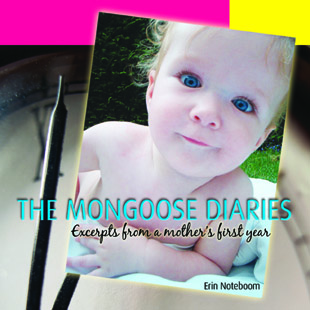 Erin Bow is the celebrated author of two children’s novels, Plain Kate and Sorrow’s Knot (as well as a physicist and poet), though the detail that intrigued me when I recently encountered her bio was that she’d also authored “a memoir that no one read.” I have sympathy for such memoirs, plus I am obstinate, so I sought out the book and discovered it was The Mongoose Diaries: Excerpts from a mother’s first year, which is up my alley, but only kind of, because I like to suppose I’m past new motherhood memoirs. But the best such memoirs are not just to be read in the moment, and The Mongoose Diaries (which Bow published under her maiden name, Erin Noteboom) is such a volume. It’s a beautiful, unsentimental and complicated depiction of life with a new baby, all the awful bound up with a pummelling love that is often more pummel than love.
Erin Bow is the celebrated author of two children’s novels, Plain Kate and Sorrow’s Knot (as well as a physicist and poet), though the detail that intrigued me when I recently encountered her bio was that she’d also authored “a memoir that no one read.” I have sympathy for such memoirs, plus I am obstinate, so I sought out the book and discovered it was The Mongoose Diaries: Excerpts from a mother’s first year, which is up my alley, but only kind of, because I like to suppose I’m past new motherhood memoirs. But the best such memoirs are not just to be read in the moment, and The Mongoose Diaries (which Bow published under her maiden name, Erin Noteboom) is such a volume. It’s a beautiful, unsentimental and complicated depiction of life with a new baby, all the awful bound up with a pummelling love that is often more pummel than love.
Noteboom’s depiction is complicated because life is—it is implied that her pregnancy has not come easily; she suffers from a painful and serious health condition; and midway through her pregnancy, she faces the devastating loss of her beloved sister, who drowns while on vacation in Mexico. And so her feelings about the impending birth of her first child are mixed up with sadness, fear and mourning, yet oddly apart from these as well (except for her painful insight into her own mother’s loss once her daughter is born and she knows the enormity of what it is to love one’s own child).
The book moves from the beginning of Noteboom’s pregnancy to her daughter’s first birthday, the reflections written as short diary entries that move between the ups and downs (and hilarity and despair) of new parenthood as easily as the hours do. What I found most interesting was Noteboom’s critique and resistance to the idea of the necessity of a mother’s self-sacrifice—as though it’s some sort of consolation that it will hurt her more than it hurts the baby, for example, when she returns to work when “the mongoose” is three months old. It’s refreshing to read a new mom memoir from the point of view of someone with a job as well, mixing up the whole experience—gross stains on pretty blouses, pumping at the office, having to feign a functioning brain on so little sleep. And yes, the guilt, though Noteboom kicks back at the guilt with all the force she can muster, (mostly) confident in the choices she’s made for her family.
The book is sweet and funny, sad and lovely, the diary entries interspersed with perfect poetry. As someone who plans to never ever have a baby ever again, The Mongoose Diaries made me so sad and glad about this at once, and also brought back memories of those tender early days in which I held the pieces of my shattered life, and had to put them back together. It reminded me of Anne Enright’s Making Babies, one of my favourite mothering memoirs, one of those rare pieces of literature which show that motherhood is not simply “a sort of journey you could send dispatches home.” But I am glad these writers do.
I am pleased too by the glimpse the memoir provides into Erin Noteboom’s creative life. The first year of motherhood is usually not an abundantly creative time for anyone, but she notes here and there the fairy tale she’s working on, a curious book about a talking cat. A book that would come to be Plain Kate, which won the TD Canadian Children’s Literature Award in 2011. Demonstrating that motherhood can indeed be part of the threshold for creative fulfillment and success, that it’s not necessarily the end of the story.
**Note: Iris is obsessed with this book. She walks around the house holding it, perfectly sized for her 15 month old hands. “Baby,” she says. I was reading it on Friday while trying to get her to go down for her nap, and had to hide it under a pillow because she would not lie down until I’d given it to her. She also chews on it. Sorry, Library.
September 19, 2014
Iris is the solution to everything
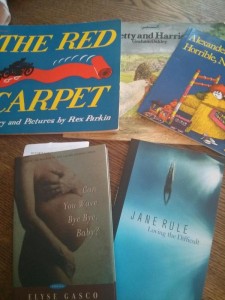 Iris is the solution to everything, namely if your “everything” is getting away with the world’s most paltry book haul from the Victoria College Book Sale (which runs all weekend). And my everything was certainly that very thing this morning, because I have so many books and the bookstore called me yesterday to let me know my order is in, plus the one I bought online yesterday direct from the publisher etc, so I didn’t need any more. So this is all I came away with, which I am quite pleased about, because under most circumstances I have absolutely no restraint.
Iris is the solution to everything, namely if your “everything” is getting away with the world’s most paltry book haul from the Victoria College Book Sale (which runs all weekend). And my everything was certainly that very thing this morning, because I have so many books and the bookstore called me yesterday to let me know my order is in, plus the one I bought online yesterday direct from the publisher etc, so I didn’t need any more. So this is all I came away with, which I am quite pleased about, because under most circumstances I have absolutely no restraint.
I’d come prepared with a cookie and a cinnamon bun, hoping these would keep Iris occupied for a little while, and they did, for about 10 minutes, as she snacked in her stroller. But then she wanted out, which she demonstrated by screaming and screaming, because Iris has recently come into her own as a piercing soprano. I ignored her for a little while, and tried to pretend there was nobody else around. And then finally, I took her out and put her in her carrier, browsing continued, popping a “dumma” (soother) into her mouth, but that peace lasted no more than sixty seconds. Who screams while sucking on a soother? But Iris wanted to go, so I let her, and that was okay, because underneath the book tables were boxes and boxes and more books, and Iris likes things in boxes, and I got to look at a whole bunch more books while she played with a box of Goosebumps paperbacks (hence my excellent picture book selection).
And then I took her upstairs to the fiction, which had no boxes under the tables at all, and she was obsessed with the big old staircase that we’d had to climb to get up there, so every time she was let loose, that was where she headed. A brief diversion was a wastebasket, and I let it go for awhile, but then she started picking things out of that box, so I shut it down. I had to hold her, and she was screaming and screaming. Again, I kept my head down and ignored everybody. Surely, I thought, they’d understand that a mother needs to get her book browsing done. A smart trick was holding Iris upside down, which was funny, so she laughed instead of screamed, but that only goes so far, and it made it hard to look for books. And so she kept on screaming, and I think some people may not have found it so charming, but what is a bookish mother to do, I ask you? Well, give up, which I eventually did, but only because I had no business buying books in the first place.
As I was leaving, a very earnest undergrad came up to me and pointed to Iris, who had since calmed down, because we were no longer looking at books. “Is that the baby that was unhappy?” she asked. Apparently Iris was getting a reputation. “Is she okay?” she asked me. “Well, she’s Iris,” I should have told her, but instead I promised her that she was. Whereupon we met my seven-months-pregnant friend and her two-year-old who’d turned an Old Vic couch into a trampoline. I am not sure the book sale is going to recover from a visit from the likes of us.
September 16, 2014
Author Interviews at Pickle Me This: Rachel Wyatt
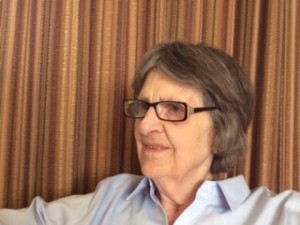 Rachel Wyatt is a prolific and award-winning author of novels, short fiction, stage and radio plays and non-fiction works. Her six novels include The Rosedale Hoax, Foreign Bodies, and Time’s Reach. A half-dozen professional productions have been mounted of her full-length stage plays, including Crackpot and For Love or Money. She has also had over 100 plays produced by CBC and BBC radio, and monologues and scenes from her works have been included in many anthologies, most recently in the Oxford Book of Stories by Canadian Women.
Rachel Wyatt is a prolific and award-winning author of novels, short fiction, stage and radio plays and non-fiction works. Her six novels include The Rosedale Hoax, Foreign Bodies, and Time’s Reach. A half-dozen professional productions have been mounted of her full-length stage plays, including Crackpot and For Love or Money. She has also had over 100 plays produced by CBC and BBC radio, and monologues and scenes from her works have been included in many anthologies, most recently in the Oxford Book of Stories by Canadian Women.
Rachel Wyatt immigrated to Canada with her family in 1957. She was Director of the Writing Program at the Banff Centre for the Arts during the 1990s and has appeared at writer’s conferences across Canada and internationally. She has won the CBC Literary Competition Drama Award and was Awarded the Order of Canada in 2002 and the Queen’s Jubilee Medal in 2003.
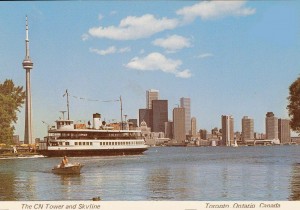 Kerry Clare: I discovered your work through Amy Lavender Harris’s Imagining Toronto, in which she wrote about The Rosedale Hoax, which is nearly 40 years old. I read The Rosedale Hoax and was impressed at how contemporary in tone it was, a wonderful depiction of Toronto and its classes and masses. It’s a very funny book.
Kerry Clare: I discovered your work through Amy Lavender Harris’s Imagining Toronto, in which she wrote about The Rosedale Hoax, which is nearly 40 years old. I read The Rosedale Hoax and was impressed at how contemporary in tone it was, a wonderful depiction of Toronto and its classes and masses. It’s a very funny book.
Rachel Wyatt: After all this time! The book began life with a fanfare. Anansi spent its entire advertising budget on large posters in the Toronto Subway. Then a woman reviewer wrote a really nasty, almost personal, piece about it in the Globe, and that more or less killed the novel at birth. At least a woman who was a realtor in Rosedale used to buy a few copies every year for a competition she ran in the area. I’m delighted that you and Amy Lavender Harris have taken notice of it.
Kerry: What was it like to be writing about Toronto in 1977? How was your vision of the city different from how you’d seen it presented in literature before?
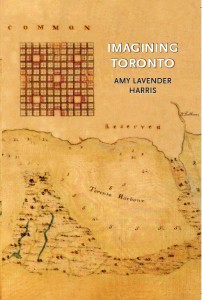 Rachel: Writing, thinking, about Toronto in 1977. Well, my own first impressions in 1957 were reflected in what was being written at that time. It was dull, cold, narrowly Protestant. Strict laughable rules about buying liquor from the store or in bars were enforced. “Men Only” signs here and there. Ladies Entrances in the pubs. By 1977 much of this had changed and I saw the more casual approach to life, as if some tight hold on the city was beginning to relax its grip. And by 1993, it was/is to me the great city I hated to leave.
Rachel: Writing, thinking, about Toronto in 1977. Well, my own first impressions in 1957 were reflected in what was being written at that time. It was dull, cold, narrowly Protestant. Strict laughable rules about buying liquor from the store or in bars were enforced. “Men Only” signs here and there. Ladies Entrances in the pubs. By 1977 much of this had changed and I saw the more casual approach to life, as if some tight hold on the city was beginning to relax its grip. And by 1993, it was/is to me the great city I hated to leave.
Kerry: Since then I’ve read your two most recent novels (Suspicion and Letters to Omar) and their narrative approach was so similar to The Rosedale Hoax. I don’t mean to imply that you’ve not grown as a writer in this time, but instead to suggest that your style has long been well-defined. It’s also singular—I can’t think of what I’d compare it to. Do you think you think you were ahead of your time? Or apart from time? How have your preoccupations changed from then to now?
Rachel Wyatt: I’ll answer the last part of your question first as it’s the easiest. If my preoccupations have changed, they have perhaps grown wider in the sense of considering the whole world—depressing as that is. In my first years in Canada (we arrived [from England] in 1957) I was looking around at this new place with wonder, delight and occasional puzzlement, and using what I saw and heard.
Yes, I have been perceived as ahead of my time and that, when it comes to selling one’s work, is not helpful.
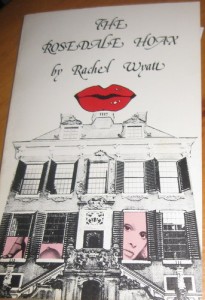 I’m not used to considering my own style, narrative habits, structure and so it’s a bit of a mystery to me. I’m only the writer. My editor has said my writing style comes out of the Brit tragi-comedy of manners. Some of my stage plays have been described in that way too. I think it’s a habit of looking at the world a little sideways on, if that makes sense. And that won’t have changed over time and certainly won’t now.
I’m not used to considering my own style, narrative habits, structure and so it’s a bit of a mystery to me. I’m only the writer. My editor has said my writing style comes out of the Brit tragi-comedy of manners. Some of my stage plays have been described in that way too. I think it’s a habit of looking at the world a little sideways on, if that makes sense. And that won’t have changed over time and certainly won’t now.
“I think it’s a habit of looking at the world a little sideways on…”
As for the way I tell a story, it’s a matter, perhaps, of beginning in the middle. I’ll keep thinking about it but if I think too much, I might stop writing.
Kerry: You do begin in the middle—in Letters to Omar this is particularly apparent. This approach much be disconcerting for readers who are used to being led through novels with their hands held. You have faith in your readers though to find their way, to figure it out (and I did! It’s all there). Or are you thinking of the readers at all? What makes the middle so compelling? Isn’t it easier to start at the start?
Rachel: Like most writers, I say that I tend not to think of potential readers while I’m writing. But just as I like to be treated as an intelligent person when I read or watch plays, so I assume readers and audiences of my work to be intelligent too. It makes me feel good to grasp something in a novel that isn’t obvious at first, or to get the ‘aha’ moment in a play. It’s part of the pleasure.
Also, starting in the middle makes the “unfolding” or revealing more fun. I keep seeing “reveal” used as a noun now. I don’t like it but I can see its uses.
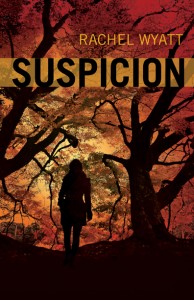 Kerry: Your latest novel, Suspicion, puts its “reveal” right at the start though, and it’s the rest of the characters in the novel who have to wait to find out the truth about what happened to Candace Wilson. (I loved this book! It’s on my Canadian Gone Girl list). What was the attraction of turning the structure of the suspense novel inside out?
Kerry: Your latest novel, Suspicion, puts its “reveal” right at the start though, and it’s the rest of the characters in the novel who have to wait to find out the truth about what happened to Candace Wilson. (I loved this book! It’s on my Canadian Gone Girl list). What was the attraction of turning the structure of the suspense novel inside out?
Rachel: Suspicion is about suspicion. Have you read Chekhov’s “In the Ravine”? It’s about gossip and how it affects lives. I wanted to show how this event, Candace’s disappearance, changed the town and the people. Whispers, rumours, “false witness” even, spread around. And when it was all over, Jack, for instance, would always know he’d been suspected of murder and even after she’d been found, of a failed attempt.
I’m very pleased that you loved it and that it’s on your Next-Gone-Girl list. Perhaps someone will make a movie of it. A big perhaps!
Kerry: Oh, the Chekhov reference is helpful here. Your work is such a fascinating puzzle, and this goes a step toward decoding it. Who are your other literary influences? And (which might the same question, or maybe not), what authors and books are most beloved to you?
Rachel: This is a big question. I look at my bookshelves and love all the writers and all their books. Influence is the hard question. I suppose writers take from just about everything they read. When Tennessee Williams was asked which three writers had influenced him most, he said, ”Chekhov, Chekhov and Chekhov.”
Virginia Woolf is a favourite, The Waves in particular. Conrad, Henry James, the ancients—The Aeneid, The Odyssey. The Brit humourists, Evelyn Waugh, P G Wodehouse and now Ian MacEwen, Martin Amis. Canadians: Mavis Gallant who was also a dear friend, unparallelled Alistair MacLeod, and of course Alice. Recently, The Sisters Brothers by Patrick de Witt and Lee Henderson’s The Man Game. In the early seventies, I was given a copy of Adele Wiseman’s Crackpot. When I’d read it, I wanted to jump up and shout, “This is the great Canadian novel”. We became friends and after she died, the CBC commissioned me to adapt Crackpot for radio, which I did. Subsequently, I adapted it for the stage and it’s had productions from coast to coast.
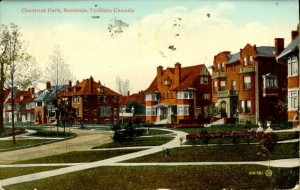 But this is becoming a biography in books. I’ve loved the classic Russians and the French. Jose Saramago’s books are amazing, Roberto Bolano. . . .
But this is becoming a biography in books. I’ve loved the classic Russians and the French. Jose Saramago’s books are amazing, Roberto Bolano. . . .
At the moment, I’m reading a dark Japanese mystery by Fuminori Makinara and re-reading after decades Ford Madox Ford’s The Good Soldier. I’ve just finished Margaret MacMillan’s The War that Ended Peace. A brilliant book but disturbing because it’s all happening again.
I won’t start on poetry and plays but I get great pleasure from reading those too.
You shouldn’t have got me started! Influence? I don’t know. But I think my use of language was helped along by going to church with Grandma and hearing the words of the King James Bible. I also eavesdrop all the time.
“I think my use of language was helped along by going to church with Grandma and hearing the words of the King James Bible. I also eavesdrop all the time.”
Kerry: No surprise that you’re an eavesdropper. You have such an ear for dialogue—I loved:
“What is stupid,” Mike went on, “is to go about having illusions about people you never knew in the first place.”
“You’re not likely to have illusions about someone you know,” Dorothy said. “Once you get to know them.”
Where so many authors would use exposition, you tell the story obliquely through characters’ conversations. Is this where your background as a playwright informs your fiction writing? And what do you love about the way people talk?
Rachel: There is poetry in the things people say and the things they don’t say. We speak often in shorthand because friends and family know what we mean to say and will cut in. A short phrase can carry a great deal of weight. Some of my short stories are, in effect, little plays. In writing for radio, everything including the scenery must be in the dialogue but not obviously. Timothy West, the actor, wrote a fine parody of a radio play entitled, “This gun that I have in my right hand is loaded.” A simple “Don’t shoot” from the other person would imply a gun—unless they’re out in the woods with bows and arrows. And so on.
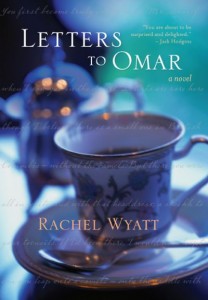 Kerry: The dialogue in Letters to Omar is fascinating in that it’s not actually dialogue—there is so little listening involved in how the characters respond to one another, which results in misunderstandings. But it’s also the way that old friends speak—they know each other so well they feel themselves beyond having to listening. Their conversations are a glorious mess. Your depiction of a lifelong friendship between three women is one of my favourite parts of this book—you show how it informs their lives (and someone else remarks, I think, that it has kept them from maturing, that they’re forever stuck in a time warp of girlhood when they’re together). Women’s friendship is still rare in literature, though common in the world, I think. What was interesting about it for you to approach as a novelist?
Kerry: The dialogue in Letters to Omar is fascinating in that it’s not actually dialogue—there is so little listening involved in how the characters respond to one another, which results in misunderstandings. But it’s also the way that old friends speak—they know each other so well they feel themselves beyond having to listening. Their conversations are a glorious mess. Your depiction of a lifelong friendship between three women is one of my favourite parts of this book—you show how it informs their lives (and someone else remarks, I think, that it has kept them from maturing, that they’re forever stuck in a time warp of girlhood when they’re together). Women’s friendship is still rare in literature, though common in the world, I think. What was interesting about it for you to approach as a novelist?
Rachel: I’m an opera fan and had been thinking about the fine duets between male friends as in The Pearl Fishers, or between Orestes and Pylades who are prepared to die for each other in Iphigeneia in Tauris. Then there are Achilles and Patroclus—I don’t think anyone’s written an opera about them. And Sidney Carton who does the “far, far better thing” and goes off to the scaffold in his friend’s place.
I can’t think of anything like that between women in opera or literature. I think I mentioned that I was reading Middlemarch. Dorothea, in that small enclosed society, doesn’t have a single true female friend. And her sister isn’t much help. Emma in Emma bestows her “friendship” on poor Harriet whom she wants to improve, with disastrous results. Elizabeth and Jane Bennet are an example of sisters who are also “best” friends.
I think friendship between women is an unseen thing, unheard and, clearly, unsung. We know who our “best” friends are. They’re the very few we trust with our secrets, who will come to our aid in time of need and so on, and for whom we do the same.
“I think friendship between women is an unseen thing, unheard and, clearly, unsung.”
Kate and Elsie and Dorothy have made a kind of web for themselves, a sort of safety net, I suppose. They will be all right as long as they jog along together, holding each other up in a crazy way. Some days they’ll dislike each other but they’ll defend each other against everyone else. Kate’s husband for instance is a villain to them all. I think it was that kind of carry-over from their college days that I liked. All of them sharing a “room” forever.
Kerry: And I’ve heard the good news that you’ll have a new short story collection published by Coteau Books in the spring. Congratulations! What can you tell us about it?
Rachel: Street Symphony will indeed be published in spring—if we can get it together in time. I’m a café addict as I may have mentioned. Six mornings a week I can be found at Café Misto down the road when it opens at 7am. I have coffee and a muffin and read the papers and talk to other regulars. Then I walk home again and talk to the people on this very short street who are setting off to work or getting the kids off to school. So some of the stories reflect all that. Who are these people who turn up for coffee so early? Why are they there? I invented new café denizens for my tales.
Another story began from seeing a grubby-looking aquarium in another café. And so on. I’ve written about the lives of people around town as I think they might be. And I hope people enjoy reading the stories—and buy the book.
